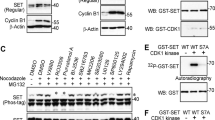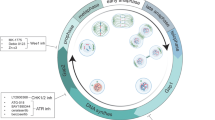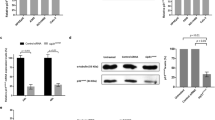Abstract
The 70 kDa ribosomal S6 kinase (p70S6K) is important for cell growth and survival. Activation of p70S6K requires sequential phosphorylation of multiple serine and threonine sites often triggered by growth factors and hormones. Here, we report that paclitaxel, a microtubule-damaging agent, induces phosphorylation of p70S6K at threonine 421 and serine 424 (T421/S424) in a concentration- and time-dependent manner in multiple breast and ovarian cancer cell lines demonstrated by a T421/S424 phospho-p70S6K antibody. Phosphoamino-acid analysis and Western blot analysis by serine-/threonine-specific antibodies further confirms that both serine and threonine residues are phosphorylated in p70S6K following treatment with paclitaxel. Paclitaxel-induced p70S6KT421/S424 phosphorylation requires both de novo RNA and protein synthesis via multiple signaling pathways including ERK1/2 MAP kinase, JNK, PKC, Ca++, PI3K, and mammalian target of rapamycin (mTOR). Despite phosphorylation of p70S6KT421/S424, paclitaxel inactivates this kinase in a concentration- and time-dependent manner as illustrated by in vitro kinase assay. Inhibitors of mTOR, PI3K, and Ca++ impair p70S6K activity, whereas inhibitors of JNK and PKC stimulate p70S6K activity. Inhibition of PKC and JNK prevents paclitaxel-induced p70S6K inactivation. Moreover, the paclitaxel-induced phosphorylation and low activity of p70S6K mainly occurs during mitosis. In summary, paclitaxel is able to induce p70S6KT421/S424 phosphorylation and decrease its activity in mitotic cells via multiple signaling pathways. Our data suggest that paclitaxel-induced p70S6KT421/S424 phosphorylation and kinase inactivation are differentially regulated. Our data also indicate that paclitaxel may exert its antitumor effect, at least in part, via inhibition of p70S6K.
This is a preview of subscription content, access via your institution
Access options
Subscribe to this journal
Receive 50 print issues and online access
$259.00 per year
only $5.18 per issue
Buy this article
- Purchase on Springer Link
- Instant access to full article PDF
Prices may be subject to local taxes which are calculated during checkout










Similar content being viewed by others
References
Akimoto K, Nakaya M, Yamanaka T, Tanaka S, Matsuda S, Weng QP, Avruch J and Ohno S . (1998). Biochem. J., 335, 417–424.
Alessi DR, Kozlowski MT, Weng QP, Morrice N and Avruch J . (1998). Curr. Biol., 8, 69–81.
Avruch J, Belham C, Weng Q, Hara K and Yonezawa K . (2001). Prog. Mol. Subcell. Biol., 26, 115–154.
Balendran A, Currie R, Armstrong CG, Avruch J and Alessi DR . (1999). J. Biol. Chem., 274, 37 400–37 406.
Belham C, Comb MJ and Avruch J . (2001). Curr. Biol., 11, 1155–1167.
Bennett BL, Sasaki DT, Murray BW, O’Leary EC, Sakata ST, Xu W, Leisten JC, Motiwala A, Pierce S, Satoh Y, Bhagwat SS, Manning AM and Anderson DW . (2001). Proc. Natl. Acad. Sci. USA, 98, 13 681–13 686.
Boonstra J, Mummery CL, Tertoolen LGJ, van der Saag PT and de Laat SW . (1981). J. Cell Physiol., 107, 75–83.
Burnett PE, Barrow RK, Cohen NA, Snyder SH and Sabatini DM . (1998). Proc. Natl. Acad. Sci. USA, 95, 1432–1437.
Chung J, Grammer TC, Lemon KP, Kazlauskas A and Blenis J . (1994). Nature, 370, 71–75.
Chung J, Kuo CJ, Crabtree GR and Blenis J . (1992). Cell, 69, 1227–1236.
Conus NM, Hemmings BA and Pearson RB . (1998). J. Biol. Chem., 273, 4776–4782.
Dennis PB, Pullen N, Kozma SC and Thomas G . (1996). Mol. Cell. Biol., 16, 6242–6251.
Edelmann HM, Kuhne C, Petritsch C, Ballou LM . (1996). J. Biol. Chem., 271, 963–971.
Ed Souza CP, Osmani AH, Wu LP, Spotts JL and Osmani SA . (2000). Cell, 102, 293–302.
Grammer TC, Cheatham L, Chou MM and Blenis J . (1996). Cancer Surv., 27, 271–292.
Han JW, Pearson RB, Dennis PB and Thomas G . (1995). J. Biol. Chem., 270, 21 396–21 403
Harada H, Andersen JS, Mann M, Terada N and Korsmeyer SJ . (2001). Proc. Natl. Acad. Sci. USA, 98, 9666–9670.
Hashemolhosseini S, Nagamine Y, Morley SJ, Desrivieres S, Mercep L and Ferrari S . (1998). J. Biol. Chem., 273, 4424–4429.
Horwitz SB . (1992). Trends Pharmacol. Sci., 13, 134–136.
Isotani S, Hara K, Tokunaga C, Inoue H, Avruch J and Yonezawa K . (1999). J. Biol. Chem., 274, 34 493–34 498.
Jefferies HB, Fumagalli S, Dennis PB, Reinhard C, Pearson RB and Thomas G . (1997). EMBO J., 16, 3693–3704.
Lane HA, Fernández A, Lamb NJC and Thomas G . (1993). Nature, 363, 170–172.
Le XF, Groner Y, Kornblau SM, Gu Y, Hittelman WN, Levanon D, Mehta K, Arlinghaus RB, Chang KS . (1999). J. Biol. Chem., 274, 21 651–21 658.
Le XF, Marcelli M, McWatters A, Nan B, Mills GB, O’Brian C and Bast Jr RC . (2001). Oncogene, 20, 8258–8269.
Li C, Yu DF, Newman RA, Cabral F, Stephens LC, Hunter N, Milas L, Wallace S . (1998). Cancer Res., 58, 2404–2409.
Luo Y, Marx SO, Kiyokawa H, Koff A, Massague J and Marks AR . (1996). Mol. Cell. Biol., 16, 6744–6751.
Mahalingam M and Templeton DJ . (1996). Mol. Cell. Biol., 16, 405–413.
Ming XF, Burgering BM, Wennestrom S, Claesson-Welsh L, Heldin CH, Boss JL, Kosma SC and Thomas G . (1994). Nature, 371, 426–429.
Montagne J, Steward MJ, Stocker H, Hafen E, Kozma SC and Thomas G . (1999). Science, 285, 2126–2129.
Mukhopadhayay NK, Price DJ, Kyriakis JM, Pelech SL, Sanghera J and Avruch J . (1992). J. Biol. Chem., 267, 3325–3335
Nakamura M, Zhou XZ, Kishi S, Kosugi I, Tsutsui Y and Lu KP . (2001). Curr. Biol., 11, 1512–1516.
Panditax TK, Gregoire V, Dhingra K and Hittelman WN . (1994). Cytogenet. Cell Genet., 67, 94–101.
Papst PJ, Sugiyama H, Nagasawa M, Lucas JJ, Maller J and Terada N . (1998). J. Biol. Chem., 273, 15 077–15 084.
Pearson RB, Dennis PB, Han JW, Williamson NA, Kozma SC, Wettenhall RE and Thomas G . (1995). EMBO J., 14, 5279–5287.
Peterson RT, Desai BN, Hardwick JS and Schreiber SL . (1999). Proc. Natl. Acad. Sci. USA, 96, 4438–4442.
Price DJ, Grove JR, Calvo V, Avruch J and Bierer BE . (1992). Science, 257, 973–977.
Pullen N, Dennis PB, Andjelkovic M, Dufner A, Kozma SC, Hemmings BA and Thomas G . (1998). Science, 27, 707–710.
Reif K, Burgering BMT and Cantrell DA . (1997). J. Biol. Chem., 272, 14 426–14 433.
Romanelli A, Martin KA, Toker A and Blenis J . (1999). Mol. Cell. Biol., 19, 2921–2928.
Schiff PB and Horwitz SB . (1980). Proc. Natl. Acad. Sci. USA, 77, 1561–1565.
Shima H, Pende M, Chen Y, Fumagalli S, Thomas G and Kozma SC . (1998). EMBO J., 17, 6649–6659.
Templeton DJ . (2001). Curr. Biol., 8, 69–81.
Thomas G . (2000). Nat. Cell Biol., 2, E71–E72.
Volarevic S and Thomas G . (2001). Prog. Nucleic Acid Res. Mol. Biol., 65, 101–127.
Weng QP, Kozlowski M, Belham C, Zhang A, Comb MJ and Avruch J . (1998). J. Biol. Chem., 273, 16 621–16 629.
Williams MR, Arthur JS, Balendran A, van der Kaay J, Poli V, Cohen P and Alessi DR . (2000). Curr. Biol., 10, 439–448.
Yaffe MB, Schutkowski M, Shen M, Zhou XZ, Stukenberg PT, Rahfeld JU, Xu J, Kuang J, Kirschner MW, Fischer G, Cantley LC, Lu KP . (1997). Science, 278, 1957–1960.
Zhou XZ, Lu PJ, Wulf G and Lu KP . (1999). Cell Mol. Life Sci., 56, 788–806.
Acknowledgements
We sincerely thank Drs J Avruch and DJ Templeton for providing mutant plasmids of p70S6K and Dr Z Siddik for providing 2008 cells. We also thank Karen Ramirez at Flow Cytometry Core Laboratory (Smith Research Building) of MD Anderson Cancer Center for her expert assistance with flow cytometry analysis.
Author information
Authors and Affiliations
Corresponding author
Additional information
Our research was supported in part by a Grant CA-39930 (to RCB) from the National Institutes of Health and by an Institutional Research Grant IRG-3721206 (to XFL) from the University of Texas MD Anderson Cancer Center
Rights and permissions
About this article
Cite this article
Le, XF., Hittelman, W., Liu, J. et al. Paclitaxel induces inactivation of p70 S6 kinase and phosphorylation of Thr421 and Ser424 via multiple signaling pathways in mitosis. Oncogene 22, 484–497 (2003). https://doi.org/10.1038/sj.onc.1206175
Received:
Revised:
Accepted:
Published:
Issue Date:
DOI: https://doi.org/10.1038/sj.onc.1206175
Keywords
This article is cited by
-
Capivasertib combines with docetaxel to enhance anti-tumour activity through inhibition of AKT-mediated survival mechanisms in prostate cancer
British Journal of Cancer (2024)
-
Potential of the dual mTOR kinase inhibitor AZD2014 to overcome paclitaxel resistance in anaplastic thyroid carcinoma
Cellular Oncology (2018)
-
Phosphorylation of AKT pathway proteins is not predictive of benefit of taxane therapy in early breast cancer
Breast Cancer Research and Treatment (2013)
-
Safety and pharmacokinetics of paclitaxel and the oral mTOR inhibitor everolimus in advanced solid tumours
British Journal of Cancer (2009)
-
Developmental regulation of p70 S6 kinase by a G protein-coupled receptor dynamically modelized in primary cells
Cellular and Molecular Life Sciences (2009)



